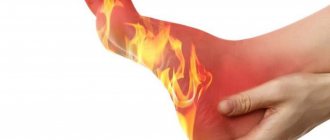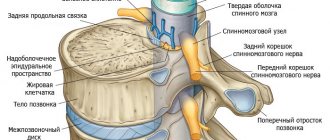Peripheral artery occlusive disease is a severe, dangerous chronic pathology characterized by a progressive course.
This concept includes several diseases: atherosclerosis obliterans, endarteritis obliterans, thromboangiitis obliterans, diabetic angiopathy, etc. Despite the fact that these diseases are of a different nature, they all manifest as chronic ischemia syndrome of the limbs or internal organs. Mostly, obliterating diseases of the peripheral arteries develop in men after forty years of age, who move little and smoke. Some types of pathologies appear earlier - at 25-30 years.
Obliterating diseases of the peripheral arteries are characterized by a violation of the flow of arterial blood to the legs. This occurs due to impaired elasticity of the arteries. Blood circulation does not occur in the required volume due to the fact that the arteries are narrowed or completely closed.
Causes of obliterating atherosclerosis of the lower extremities
Obliterating atherosclerosis of the vessels of the lower extremities is a manifestation of systemic atherosclerosis.
For this reason, its occurrence is associated with the same mechanisms that cause other atherosclerotic processes. Lesions are caused by:
- changes in the condition of the vascular walls;
- dysfunction of the receptor apparatus;
- hereditary factor.
People who are susceptible to pathology are:
- smoke;
- suffer from high cholesterol levels;
- lead a sedentary lifestyle.
Often, blockage of blood vessels occurs when:
- arterial hypertension;
- diabetes mellitus;
- rheumatism;
- obesity;
- hypothyroidism.
Why does it happen?
The main reason for the development of pathology is atherosclerosis. Males are more susceptible to the disease than females, particularly older men. According to statistics, the disease manifests itself less frequently in older women.
There are many factors that increase the risk of pathology. This includes not only long-term smoking.
- People suffering from diabetes are susceptible to this disease.
- Peripheral vascular pathology is at risk of developing in people with persistently high blood pressure.
- Antibodies that disrupt the human immune system can be formed due to exposure to systemic pathologies. Often, pathology of peripheral veins develops due to increased cholesterol in the blood vessels.
- The likelihood of developing pathologies of the vascular system increases if a person is obese. The greater the weight deviation from the norm, the higher the risk of pathology.
Classification of the disease
There are several stages of vascular atherosclerosis:
- First. At this stage of development of the pathology, the patient can walk more than 1 kilometer without pain. Discomfort usually occurs only during active physical activity.
- Second. At this stage of atherosclerosis of the vessels of the lower extremities, the patient can walk 50-1000 meters without discomfort.
- Third. It is called the stage of critical ischemia. The patient can walk less than 50 meters without pain. Discomfort often occurs even at rest, at night.
- Fourth. With this development of pathology, trophic disorders occur in the fingers and heel areas. They can lead to gangrene of the limbs.
Obliterating atherosclerosis is a dangerous disease. It ranks 3rd in the structure of mortality from cardiovascular pathologies. With obliterating atherosclerosis, there is a high risk of developing gangrene, which leads to the need for limb amputation. The course of the pathology is especially unfavorable for patients with diabetes mellitus.
Treatment
Treatment is aimed at restoring normal blood circulation in the affected area.
To do this, they can use agents that improve the rheological properties of blood (fluidity), as well as those that activate metabolic processes in tissues and reduce the level of atherogenic lipids in the blood. Anti-inflammatory drugs are sometimes prescribed.
In the later stages of the disease, surgery may be prescribed to restore impaired blood flow.
If gangrene develops, the limb may need to be amputated.
Symptoms of obliterating atherosclerosis of the vessels of the lower extremities
For a long time, the pathology is asymptomatic. The first clinical manifestation is often embolism or thrombosis. Usually the pathology develops gradually.
Its initial signs include:
- numbness of the feet and feeling of chilliness;
- burning of the skin.
Symptoms of the development of pathology include:
- pain in the calves;
- intermittent claudication.
Vascular pathology leads to:
- changes in skin color;
- hair loss on the thighs and legs;
- delamination of nail plates.
The fact that the patient is at risk of gangra is indicated by a symptom such as the presence of non-healing trophic ulcers.
Important! Even the smallest injuries to a limb can lead to the development of necrosis.
Obliterating endarteritis of the vessels of the legs: causes of development
Vascular surgeons around the world are still actively discussing the causes of endarteritis and cannot come to a common denominator. Therefore, it is believed that several factors play a role in the etiology of endarteritis. Autoimmune causes, conditions accompanied by blood thickening, and all kinds of infections are considered. The influence of dysfunction of the endocrine system, intoxication of the body due to renal and liver failure, physical inactivity during diseases that confine a person to bed and limit motor activity, for example: paralysis, inflammation of the sciatic nerve, fractures, burns and other injuries, cannot be ruled out.
It is reliably known that the leading cause of endarteritis is long-term smoking. This bad habit leads to the fact that harmful substances, accumulating on the inner surface of the vessels, cause aseptic inflammation due to the activation of autoimmune processes.
Regardless of what led to the onset of the disease, the pathogenesis of endarteritis develops according to one scenario. Initially, the affected vessels spasm, which leads to thickening of the muscle layer of the wall and impaired blood circulation in them. Due to the slow blood flow, platelets and other blood elements quickly stick to the inner surface of the vessels, and blood clots form. Destruction of the morphological structure leads to organic changes in the form of narrowing and then complete closure of the vessel section.
The body strives to compensate for the violation and stimulates the growth of bypass vessels, but the newly emerged collateral network cannot fully meet the needs of the tissues. At first, this manifests itself only under very heavy loads, then during everyday activities, and, eventually, even at complete rest.
Diagnosis of obliterating atherosclerosis of the lower extremities
The following methods are used to detect vascular pathology:
- Determination of pulsation of the arteries of the extremities.
- Blood pressure measurement with calculation of the ankle-brachial index.
- Duplex scanning of arteries.
- MR angiography.
- MSCT angiography.
- Peripheral arteriography.
Modern techniques make it possible to identify the extent of damage and its causes.
During duplex scanning and ultrasound diagnostics, for example, the patency of the arteries is determined and the degree of blood supply to the affected limb is assessed. Peripheral angiography determines the extent and extent of the lesion. Tomographic studies are performed to confirm the results of contrast angiography. Diagnostics is comprehensive!
Diagnostics
Essential information about the localization of arterial occlusive disease is provided by palpation and auscultation of the vessels of the leg. Thus, the absence of a pulse in the popliteal artery indicates obliteration of the femoropopliteal segment, and the disappearance of a pulse in the thigh indicates damage to the iliac arteries. All patients should undergo auscultation of the femoral, iliac arteries and abdominal aorta. A systolic murmur is usually heard over stenotic arteries. With stenosis of the abdominal aorta and iliac arteries, it can be clearly identified not only over the anterior abdominal wall, but also on the femoral arteries under the inguinal ligament. Various tests can also be informative. For example, the Panchenko knee phenomenon is determined in a sitting position. The patient, having thrown the diseased leg over the knee of the healthy one, soon begins to experience pain in the calf muscles, a feeling of numbness in the foot, and a crawling sensation in the fingertips of the affected limb. Goldflam test - in the position of the patient on his back with his legs raised above the bed, he is asked to flex and extend the ankle joints. If blood circulation is impaired, after 10-20 movements the patient experiences fatigue in the leg. At the same time, the color of the plantar surface of the feet is monitored (Samuels test). With severe lack of blood supply, the feet become pale within a few seconds. Rheography and Doppler ultrasound help to determine the degree of ischemia of the lower limb.
Treatment of obliterating atherosclerosis of the lower extremities
When choosing treatment methods, the doctor is guided by:
- prevalence of the disease;
- the nature of the pathology;
- degree.
To slow down the progress of atherosclerotic changes, it is important to eliminate all risk factors.
Specialists use techniques that allow:
- Adjust blood pressure levels.
- Restore lipid and carbohydrate metabolism.
It is important for the patient to quit smoking and improve their diet.
Drug treatment of obliterating atherosclerosis is carried out with drugs that:
- reduce red blood cell aggregation;
- reduce the likelihood of blood clots;
- reduce vascular spasms.
Analgesics are prescribed to relieve pain. In cases of severe pain, paravertebral and paranephric blockades are performed. For embolism and thrombosis, thrombolytics and anticoagulants are administered intravenously or subcutaneously.
Non-drug treatment of the disease is carried out by:
- Hyperbaric oxygenation.
- Physiotherapy.
- Balneological procedures.
- Ozone therapy.
For trophic ulcers, the patient is given dressings with topical medications.
Surgical treatment of grade 2-3 pathology can be carried out by:
- Open interventions.
- Endovascular interventions.
Today, doctors have mastered and implemented the following techniques:
- stenting of affected arteries;
- bypass;
- prosthetics of the affected vessel;
- arterialization of the veins of the foot;
- endarterectomy;
- thromboembolectomy.
With grade 4 obliterating atherosclerosis, limb amputation may be indicated.
The treatment method is always selected only by a doctor! Today, all specialists are focused on preserving the limb and carefully determine the appropriate methods to eliminate existing problems with arterial patency. Our clinic is no exception. All doctors have the necessary experience and knowledge to carry out successful manipulations.
We never inflate the price of consultations and procedures. Thanks to this, everyone can take advantage of the help of professionals. You can clarify the prices of services and their features from specialists in Moscow by phone or in person.
Treatment methods for peripheral arteries
The treatment method depends on the degree of development of the disease, as well as on the affected area. The main goal of treatment is to stop the progression of the disease and minimize the risk of complications.
The patient is prescribed a course of treatment, in addition, he is advised to eat right, change his lifestyle, and give up alcohol and smoking. All bad habits negatively affect human blood vessels.
If treatment of peripheral arterial lesions is started earlier, the course of treatment will be compliance with preventive measures.
Medicines prescribed are those aimed at regulating cholesterol levels. Sometimes the course of treatment includes drugs that reduce the effect of platelets. These medications are aimed at thinning the blood, which is a good prevention of blood clots.
Conservative treatment is used if the disease is mild. In case of severe damage to the peripheral arteries, surgical treatment is necessary.
If large arteries are damaged, a surgical procedure is used - angioplasty. A flexible catheter is inserted into the arterial lumen through the femoral vein, then a conductor is inserted, which delivers a special balloon to the place where the vessel is narrowed. By inflating this balloon, the normal lumen of the vessel is mechanically restored.
In more advanced cases, arterial bypass surgery is performed. An additional vessel is created through which blood flow is allowed, bypassing the affected area. For this purpose, both artificial prosthetic vessels and the patient’s own veins are used.
Sometimes surgical removal of atherosclerotic plaque is used. To do this, the artery is opened, but this procedure can disrupt blood flow through the vessel.
The most radical surgical treatment method is amputation of the limb; this method is used only in case of gangrene development.
Prevention of obliterating atherosclerosis of the lower extremities
Like any other disease, it is easier to prevent than to treat.
General preventive measures include:
- Elimination of existing risk factors for the development of atherosclerosis.
- Prevention of any foot injuries.
- Preventive and hygienic foot care.
- Wearing comfortable shoes.
Patients with various pathologies of the cardiovascular system require systematic courses of therapy.
If an obstruction has already been detected, reconstructive surgery should be performed as soon as possible. It will allow you to save the limb. By using the help of specialists, you can significantly improve the quality of your life.
Important! Any prevention will be effective if you carry it out under the constant supervision of your doctor. Often a whole group of specialists (surgeons, therapists, cardiologists, phlebologists) is involved in the manipulations.
Doctor's comment
Do you have obliterating disease of the arteries of the lower extremities, and you do not know where to conduct an examination and complex adequate therapy according to the severity of your disease? Our clinic uses the most modern diagnostic and treatment methods, including original ones. We are opposed to a single template for the treatment of patients with obliterating diseases of the arteries of the lower extremities. For each patient, we select a set of conservative treatment methods, based on the individual characteristics of the course of the disease, the presence and severity of concomitant pathology, physical and social activity, attitude towards one’s disease, and motivation for a good long-term result. Make an appointment with a vascular surgeon and you will learn everything about the nature and prognosis of your disease. Together with you, we will draw up not only a detailed examination plan to identify risk factors for complex treatment, but also determine the optimal set of conservative treatment methods for you, allowing you to minimize the risk of possible complications and side effects of medications and achieve a good result. We rely on our many years of experience, the principles of continuity in treatment and family medicine, the “open door” principle, when the patient has the right to consult a doctor if necessary at any time. We will determine the frequency of further follow-up examinations and preventive courses of treatment for timely prevention and elimination of recurrent ischemia, correction of basic conservative treatment. Considering the chronic, constantly progressive and multi-causal nature of OZANK, the “treat and forget” principle should be considered detrimental. Together with you, we will try not only to save you from severe manifestations of the disease and its possible relapse, but also to significantly improve the quality of your life in the future.
Head of the Vascular Surgery Center Girsiashvili Aleko Givievich
Classification of vascular diseases of the lower extremities
• Atherosclerosis • Endarteritis • • Vascular obstruction • Blockage of deep veins • Thrombophlebitis
Until recently, diseases related to pathological conditions of the veins of the lower extremities were found in certain groups of people, such as: athletes, machine workers, salesmen, police officers - professions associated with prolonged standing. However, in our time, diseases are becoming more and more common among people who experience minimal stress on their legs due to their profession and lifestyle.
Varicose veins
– a disease in which the flexibility and elasticity of the veins decrease. Over time, the veins stretch and become deformed. The pathological process occurs against the background of improper operation of the valves of the venous system, leading to reverse blood flow. This condition can occur due to the absence or damage of valves, as well as be the result of hereditary defects. As a result of the backflow of blood, there is a local overflow of the veins with blood and, as a result, their expansion. The disease is characterized by a slow course, the symptoms of the disease increase over the years.
What symptoms are characteristic of varicose veins? First of all, the patient experiences a feeling of heaviness in the legs, increased fatigue of the lower extremities is observed, and visually, expansion of the saphenous veins can be seen in the legs.
Cramps may occur in the calf muscles, which are more common at night. In the evening, severe swelling of the feet and legs appears. The disease is very serious, as it can cause the following types of complications: the development of severe bleeding, thrombophlebitis, the formation of skin ulcers and eczema.
Disease prevention
There are a number of preventive measures that will reduce the risk of progression of arterial disease:
- The best prevention of the development of arterial pathology is an active lifestyle.
- Proper and balanced nutrition will provide the human body with minerals and trace elements, the lack of which can provoke the development of vascular disease.
- Constant monitoring of blood cholesterol levels.
- Taking medications for high blood pressure.
- Excluding spicy and fatty foods from the menu.
- Animal fat should be completely replaced with vegetable fat.
- Monitor your blood sugar readings.
- Quitting smoking and alcohol.
- Watch your weight.
- Taking aspirin to prevent blood clots.
- Hiking in comfortable shoes.
Treatment of the disease
After confirmation of the diagnosis, a treatment program is developed taking into account the stage and other nuances of the development of the disease. Therapy also involves the treatment of concomitant pathologies that contribute to the formation of obliterating atherosclerosis.
It is possible to completely cure obliterating atherosclerosis only with the help of artery replacement. However, such a radical method of solving the problem is resorted to only in the last stages of the disease. In the first two phases, the use of medications is limited.
Drug treatment
Treatment with drugs can eliminate the pain characteristic of obliterating atherosclerosis and stop the further formation of cholesterol plaques.
The patient may be prescribed:
- statins (Fluvastatin, Rosuvastatin), which regulate the amount of cholesterol in the blood;
- antispasmodics (No-shpa, Galidor, Papaverine) and ganglion blockers (Pentamin), which relieve vasospasm and help improve blood circulation in small arteries;
- anticoagulants (Heparin, Warfarin) and antiplatelet agents (Aspirin), which help reduce blood clotting and prevent the formation of blood clots;
- painkillers (Novocaine) to relieve acute attacks of pain;
- antioxidants (ascorbic acid) to protect arterial walls at the cellular level.
Drug therapy is also required after successful surgery. With systemic atherosclerosis, there is always the possibility of relapses. You will have to take the pills for life.
Surgery
Medicine has developed several gentle and radical methods of surgical intervention. Minimally invasive surgeries are safer, but they are used only when the disease affects a small area of the artery.
- Balloon angioplasty is a minimally invasive intravascular operation that allows you to restore the normal patency of a vessel by inserting a special balloon into its cavity, expanding the lumen.
- Bypass surgery is a procedure to restore blood flow by bypassing the site of narrowing using a shunt (part of the patient's healthy vein or its artificial equivalent).
- Stenting is the installation of a frame into the lumen of a vessel to expand in diameter and support the walls of the area narrowed by the pathological process.
- Autodermoplasty of the skin is the reconstruction of an area of the skin with extensive trophic lesions.
- Vascular replacement is the removal of an occluded vessel and its replacement with a graft.
- Vascular endarterectomy—cholesterol plaque is removed from the vessel along with the altered inner lining of the vessel wall.
In case of irreversible pathological processes in the limb, amputation is used. This is a necessary measure to stop gangrenous infection and avoid death. After surgery to remove a limb, continued vascular treatment is required.
Folk remedies
Traditional medicine is an effective addition to medical therapy, but cannot be its replacement, especially at stages 3–4 of atherosclerosis. Before using a traditional recipe, you should consult your doctor for any contraindications.
Hawthorn
The plant helps reduce cholesterol levels. Recipes:
- Mash 200 g of fresh ripe berries, pour a glass of alcohol. Leave for 3 weeks, filter. Take one teaspoon half an hour before meals and before bed.
- One teaspoon of lingonberries and one tablespoon each of hawthorn and immortelle are poured into 1 liter of boiling water and infused for 3 hours in a thermos. Drink one glass a day.
horse chestnut
Relieves inflammation, heals wounds, strengthens blood vessels and improves blood circulation. 20 grams of crushed peel or flowers are poured into 1 liter of water and boiled for 30 minutes in a water bath. After straining, boiling water is added to compensate for the water evaporated in the bath. Dosage - 2 tablespoons per day.
Clover
An effective remedy for lowering cholesterol levels. 2 glasses of fresh red clover flowers are poured with 1 liter of vodka and left for 2 weeks, shaking occasionally. After straining, take 1 tablespoon before breakfast and dinner.
Valerian root
Helps relieve swelling. Moisten gauze with pharmaceutical tincture and apply to areas of swelling for several hours.
Lifestyle and diet
If you only take pills, but do not change the lifestyle that led to the destruction of your health, the treatment will not be effective. First of all, you need to give up bad habits.
Alcohol increases swelling, and nicotine causes vasoconstriction and poor circulation in the extremities, so you need to stop drinking and smoking.
To normalize metabolism and improve blood circulation, therapeutic exercises are indicated. Walking exercises are especially useful. You can start with short distances and a slow pace, gradually increasing the load. Exercises should be regular, since their implementation prevents further damage to the muscles involved in exercise by atherosclerosis.
Overexertion is also not recommended, so the degree of stress should be regulated by a doctor depending on the condition of the body. General tonic exercises must be alternated with breathing exercises that help saturate tissues with oxygen.
To treat atherosclerosis, it is necessary to adjust the diet in order to reduce cholesterol levels and normalize weight. You should adhere to fractional meals (small portions 5–6 times a day), and do fasting days. It is recommended to replace smoked and fried foods with boiled and stewed ones, and limit the consumption of hot seasonings and salt. Preference should be given to lean dishes, and red meat should be completely abandoned. You should also exclude strong tea and coffee, sugar, sweets, store-bought mayonnaise and ketchup, and flour products.
Superficial thrombophlebitis
Thrombophlebitis is the most common reason for visiting a vascular doctor. Thrombophlebitis is a pathology in which acute thrombosis of a vein is observed in combination with an inflammatory process of the venous wall and surrounding tissues. The inflammatory process in thrombophlebitis occurs without the participation of microorganisms. In most cases, thrombophlebitis occurs against the background, and in rare cases the disease occurs in unchanged veins.
Thrombophlebitis occurs more often in people over 60 years of age. Provoking factors are: obesity, taking hormonal drugs, oncological pathologies, infectious diseases, pregnancy and childbirth, operations. Most often, thrombophlebitis with varicose veins affects the upper third of the leg and the lower part of the thigh. Symptoms of thrombophlebitis are redness of the skin in the projection of the pathologically altered vein, the occurrence of severe pain when touching such an area. A slight deterioration in general condition may also occur: fever and general malaise.












